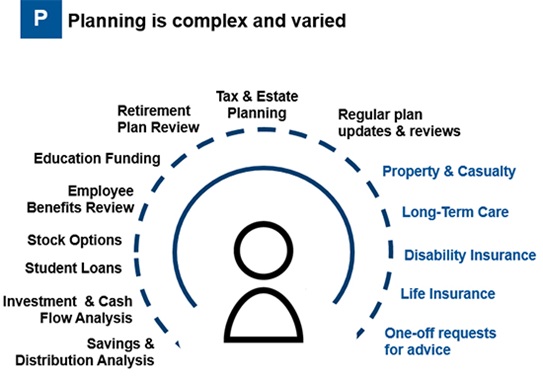Is a financial advisor worth the cost?
My grandfather came to the U.S. from Ireland in the early 1900s. When I was a child, he would tell me, Nothing in this world is for free and if someone tells you otherwise, walk the other way. I was reminded of this when I recently saw online ads for free financial planning and no cost ETFs*.
Can something as important as wealth planning be offered for free? How could a company pay its employees when it offers free ETFs?
My grandfather believed in a good deal, but a good deal isn't only about cost.
I believe it's critically important to understand what you are getting for the price you pay.
Understand the price you pay
The U.S. airline industry was deregulated in 1978. Deregulation brought competition and innovation, including more airlines, different routes and lower prices. Then came a tipping point in the late 1990s: The technology boom created an online real time marketplace for purchasing airline tickets. The race to the lowest price was underway. According to Capt. Sullenberger’s book, “Highest Duty: My Search for What Really Matters,” to stay price competitive, regional airline carriers began hiring college graduates at entry-level wages and trained them to get their commercial pilots license. Prior to 2013, the U.S. Federal Aviation Administration's (FAA) requirement to become a first officer in the cockpit was 250 hours of flight time. This was the only way for regional airlines to remain competitive given that overseas airlines only require first officers to have 200 hours of flight experience.
The FAA changed the required number of flight hours for a first officer from 250 to 1,500 in 2013 due to a tragic crash in Buffalo, New York, four years earlier.1 Even though today’s planes benefit from technology and automatic pilot, I want an experienced pilot at the controls when I’m flying through a storm or a flock of birds fly into the engine. Understanding what you are getting for the price you pay is crucial for your safety.
In the last decade, the financial services industry has gone through a lot of change. Technology and modern business models have given more investors direct access to markets. Today, there are thousands of investment options for investors with even the most modest amount of assets. These solutions come in the form of robo-advisors. The robo solutions are getting many investors started at a younger age and are teaching them the importance of saving and being disciplined. However, robo-advisors are not a replacement for a full-service financial advisor. Robo-advisors provide the basic building blocks of investment management which are asset allocation, security selection and portfolio construction.
Certified Financial Planner
footIn contrast, full-service financial advisors focus on goals and objectives that take time, planning and ongoing coordination to accomplish. Financial advisors who are Certified Financial Planners (CFP) must meet every requirement of the CFP board. To begin, a candidate must have 6,000 hours of professional experience or 4,000 hours of apprentice experience. The exam process can take up to seven years to complete. The exam spans over two days of testing. In 2018, the pass rate on the exam was 60%.2 In Canada, there are different paths to becoming a Certified Financial Planner, but the process is equally as time-intensive. It’s interesting to think that prior to 2013, the airline industry only required 250 hours of experience to fly a plane when the Certified Financial Planning board requires 24 times that amount to sit for their exam. Planning is a complex and specialized experience personalized for the individual. The following topics cover the various areas of planning:

How many hours of meetings, preparation and follow-up would it take to cover these topics appropriately? How could a company offer this for free? More importantly, what is the cost of not instituting an appropriate plan? In this regard, we believe a financial advisor is priceless.
Understand why it’s important
In Malcolm Gladwell’s book “Outliers,” he dedicates a chapter to what researchers have come to identify as the 10,000 hour rule. The rule states that for an individual to achieve a level of mastery, they must dedicate 10,000 hours of practice to the subject. To put 10,000 hours into perspective, most people only work 2,000 hours per year. So, any professional working in a field for more than five years would be considered a qualified expert. In my mind, five years isn’t a lot of time—however, many investors are taking responsibility for their portfolios with little to no experience.
We believe wise advisors educate investors on understanding the products and services they receive for the price they pay. We also believe it’s important for investors to understand the value they are receiving and the process you’re providing in helping them achieve their outcomes.
The bottom line
I’ve learned that goods and services are priced a certain way for a reason. The most important thing to discover is WHY they’re priced that way. Sometimes, a bad purchase based on price is a learning experience. However, some bad decisions based on the price of a good or a service can leave irreparable damage that cannot be undone. Next time a deal seems too good to be true, remember to do your due diligence. Spend extra time analyzing why the deal is so good and be sure that the consequences aren’t devastating.
Joe McNally, CFP®, AIF® is a Regional Director at Russell Investments.
* ETFs: Exchange-Traded Funds
1 Source: FAA.gov
2 Source: CFP.net